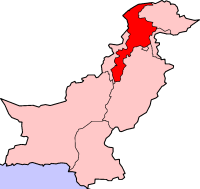
Phallaceae is a family of fungi, commonly known as stinkhorns, within the order Phallales. Stinkhorns have a worldwide distribution, but are especially prevalent in tropical regions. They are known for their foul-smelling, sticky spore masses, or gleba, borne on the end of a stalk called the receptaculum. The characteristic fruiting-body structure, a single, unbranched receptaculum with an externally attached gleba on the upper part, distinguishes the Phallaceae from other families in the Phallales. The spore mass typically smells of carrion or dung, and attracts flies, beetles and other insects to help disperse the spores. Although there is great diversity in body structure shape among the various genera, all species in the Phallaceae begin their development as oval or round structures known as "eggs". The appearance of Phallaceae is often sudden, as gleba can erupt from the underground egg and burst open within an hour. According to a 2008 estimate, the family contains 21 genera and 77 species.

The genus Phallus, commonly known as stinkhorns, is a group of basidiomycetes which produce a phallic, often foul-scented mushroom, from which their name is derived. The genus has a widespread distribution and, according to a 2008 estimate, contains 18 species. They belong to the family Phallaceae in the order Phallales. The best known species is the common stinkhorn.
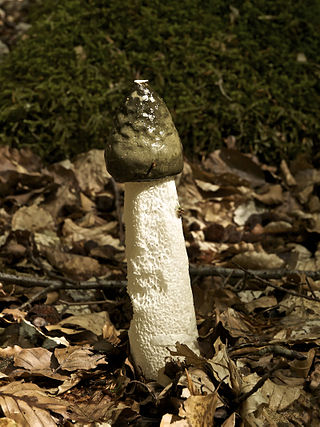
Phallus impudicus, known colloquially as the common stinkhorn, is a widespread fungus in the Phallaceae (stinkhorn) family. It is recognizable for its foul odor and its phallic shape when mature, the latter feature giving rise to several names in 17th-century England. It is a common mushroom in Europe and North America, where it occurs in habitats rich in wood debris such as forests and mulched gardens. It appears from summer to late autumn. The fruiting structure is tall and white with a slimy, dark olive colored conical head. Known as the gleba, this material contains the spores, and is transported by insects which are attracted by the odor—described as resembling carrion. Despite its foul smell, it is not usually poisonous and immature mushrooms are consumed in parts of France, Germany and the Czech Republic.

Phallus ravenelii, commonly known as Ravenel's stinkhorn, is a fungus in the Phallaceae (stinkhorn) family. It is found in eastern North America. Its mushrooms commonly grow in large clusters and are noted for their foul odor and phallic shape when mature. It is saprobic, and as such it is encountered in a wide variety of habitats rich in wood debris, from forests to mulched gardens or sawdust piles in urban areas. It appears from August to October. The fruit body emerges from a pink or lavender-colored egg to form a tall, cylindrical, hollow and spongy white stalk with a bell-shaped cap. The remains of the egg persist as a white to pink or lilac volva at the base of the stalk. The cap is covered in a foul-smelling olive-green spore slime, which attracts insects that help to spread the spores. Sometimes, the cap has a "veil" attached—a thin membrane that hangs underneath. The lack of a roughly ridged and pitted cap differentiates it from the closely related Phallus impudicus. The fungus is named after Henry William Ravenel, a botanist who first discovered it in 1846, though it remained undescribed until 1873. It is considered to be an edible mushroom while in its egg form.
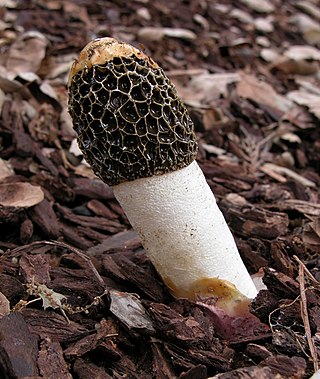
Phallus hadriani, commonly known as the dune stinkhorn or the sand stinkhorn, is a species of fungus in the Phallaceae (stinkhorn) family. The stalk of the fruit body reaches up to 20 cm (8 in) tall by 4 cm thick, and is spongy, fragile, and hollow. At the top of the stem is a ridged and pitted, thimble-like cap over which is spread olive-colored spore slime (gleba). Shortly after emerging, the gleba liquefies and releases a fetid odor that attracts insects, which help disperse the spores. P. hadriani may be distinguished from the similar P. impudicus by the presence of a pink or violet-colored volva at the base of the stem, and by differences in odor.

Phallus rubicundus is a species of fungus in the stinkhorn family. First described in 1811, it has a wide distribution in tropical regions. It has the typical stinkhorn structure consisting of a spongy stalk up to 15 cm (5.9 in) tall arising from a gelatinous "egg" up to 3 cm (1.2 in) in diameter. Atop the stalk is a pitted, conical cap that has a foul-smelling, gelatinous, green spore mass spread over it.

Calostoma is a genus of 29 species of gasteroid fungi in the suborder Sclerodermatineae. Like other gasteroid fungi, Calostoma do not have the spore discharge mechanism associated with typical gilled fungi (ballistospory), and instead have enclosed spore-bearing structures. Resembling round puffballs with raised, brightly colored spore openings (ostioles), elevated on a thick, gelatinous stalks, species have been collected in regions of deciduous, temperate, tropical or subtropical forests. Their distribution includes eastern North America, Central America, Asia, and Australasia. The common name given to some species, "prettymouth", alludes to the brightly colored raised openings (ostioles) that may somewhat resemble lips. Other common names include "hotlips" and "puffball in aspic".

Bovista is a genus of fungi commonly known as the true puffballs. It was formerly classified within the now-obsolete order Lycoperdales, which, following a restructuring of fungal taxonomy brought about by molecular phylogeny, has been split; the species of Bovista are now placed in the family Agaricaceae of the order Agaricales. Bovista species have a collectively widespread distribution, and are found largely in temperate regions of the world. Various species have historically been used in homeopathic preparations.

Bovista plumbea, commonly known as the tumbling puffball, tumbleball, or paltry puffball, is a small puffball mushroom commonly found in Western Europe and California, white when young and greyish in age. Easily confused with immature Bovista dermoxantha, it is attached to the substrate by a tuft of mycelium.

Bovista dermoxantha is a small, white, nearly round puffball, recognized when young by a cottony-felty outer surface that becomes inconspicuously warted, eventually leaving fine, pallid, scales on an ochre to brown endoperidium. Bovista plumbea is similar, but has a smoother surface when young, and lacks a basal mycelial cord. In age it is distinguished by a dull greyish endoperidium. Large specimens of Bovista dermoxantha may also be mistaken for Bovista pila. Both have a mycelial cord attachment to the substrate, but Bovista pila differs in releasing spores through tears or splits in the endoperidium rather than by an apical pore.
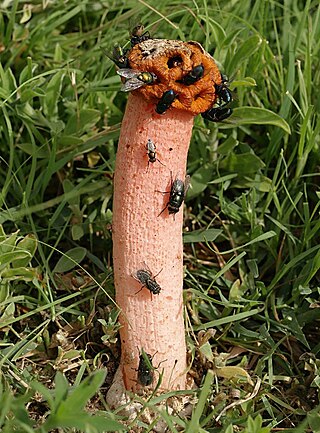
Lysurus periphragmoides, commonly known as the stalked lattice stinkhorn or chambered stinkhorn, is a species of fungus in the stinkhorn family. It was originally described as Simblum periphragmoides in 1831, and has been known as many different names before being transferred to Lysurus in 1980. The saprobic fungus has a pantropical distribution, and has been found in Africa, Asia, Australasia, and the Americas, where it grows on fertile ground and on mulch. The fruit body, which can extend up to 15 cm (5.9 in) tall, consists of a reddish latticed head placed on top of a long stalk. A dark olive-green spore mass, the gleba, fills the interior of the lattice and extends outwards between the arms. Like other members of the family Phallaceae, the gleba has a fetid odor that attracts flies and other insects to help disperse its spores. The immature "egg" form of the fungus is considered edible.
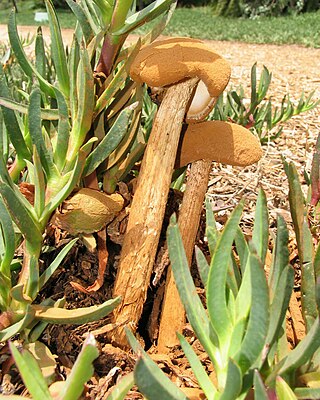
Battarrea phalloides is an inedible species of mushroom in the family Agaricaceae, and the type species of the genus Battarrea. Known in the vernacular as the scaley-stalked puffball, sandy stiltball, or desert stalked puffball, it has a woody, slender, and shaggy or scaly stem that is typically up to 40 centimeters (15.7 in) in length. Although its general appearance resembles an agaric with stem and gills, atop the stem is a spore sac, consisting of a peridium and a powdery internal gleba. In maturity, the spore sac ruptures to release the spores. Battarrea phalloides is found in dry, sandy locations throughout the world, and has been collected from Africa, Asia, Australia, Europe, North America, and South America. There is currently some disagreement in the literature as to whether the European B. stevensii is the same species as B. phalloides.

Handkea utriformis, synonymous with Lycoperdon utriforme, Lycoperdon caelatum or Calvatia utriformis, is a species of the puffball family Lycoperdaceae. A rather large mushroom, it may reach dimensions of up to 25 cm (10 in) broad by 20 cm (8 in) tall. It is commonly known as the mosaic puffball, a reference to the polygonal-shaped segments the outer surface of the fruiting body develops as it matures. Widespread in northern temperate zones, it is found frequently on pastures and sandy heaths, and is edible when young. H. utriformis has antibiotic activity against a number of bacteria, and can bioaccumulate the trace metals copper and zinc to relatively high concentrations.

Pseudocolus fusiformis is a stinkhorn mushroom in the Phallaceae, a family well known for a remarkable range of fruit body types. It is commonly known as the stinky squid, because of its fetid odor, and its three or four upright "arms" which are connected at the top. The malodorous smell comes from the dark greenish slimy gleba covering the inside faces of the arms, and attracts insects that help to disperse the spores.

Geastrum fimbriatum, commonly known as the fringed earthstar or the sessile earthstar, is an inedible species of mushroom belonging to the genus Geastrum, or earthstar fungi.

Mutinus elegans, commonly known as the elegant stinkhorn, the dog stinkhorn, the headless stinkhorn, or the devil's dipstick, is a species of fungus in the Phallaceae (stinkhorn) family. The fruit body begins its development in an "egg" form, resembling somewhat a puffball partially submerged in the ground. As the fungus matures, a slender orange to pink colored stalk emerges that tapers evenly to a pointed tip. The stalk is covered with a foul-smelling slimy green spore mass on the upper third of its length. Flies and other insects feed upon the slime which contains the spores, assisting in their dispersal.

Agaricus deserticola, commonly known as the gasteroid agaricus, is a species of fungus in the family Agaricaceae. Found only in southwestern and western North America, A. deserticola is adapted for growth in dry or semi-arid habitats. The fruit bodies are secotioid, meaning the spores are not forcibly discharged, and the cap does not fully expand. Unlike other Agaricus species, A. deserticola does not develop true gills, but rather a convoluted and networked system of spore-producing tissue called a gleba. When the partial veil breaks or pulls away from the stem or the cap splits radially, the blackish-brown gleba is exposed, which allows the spores to be dispersed.

Aseroe floriformis is a species of fungus in the stinkhorn family Phallaceae. Described as a new species in 2005, it is known only from northeast Brazil, where it grows on sandy soil. The fruit body has a raspberry-colored stipe, and, unlike other members of the genus Aseroe does not have radiating branches.

Phallus atrovolvatus is a species of fungus in the stinkhorn family. Found in Costa Rica, it was described as new to science in 2005.

Scleroderma polyrhizum, commonly known as the star earthball or dead man's hand, is a basidiomycete fungus and a member of the genus Scleroderma, or "earthballs". Found in dry, sandy soils, this species begins completely buried before slowly forcing the soil aside as it cracks apart to form a rough, star-shaped body with a diameter of 12–15 cm (4.7–5.9 in). At the center is the dark, brownish spore mass. Widely distributed wherever the soil and climate are favorable, it is known from Asia, Europe, and the Americas.

